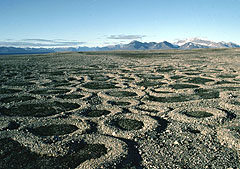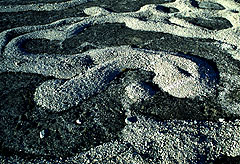|
January 20, 2003
Scientists explain formation of stone circles,
other strange patterns in northern regions
By Tim Stephens
Perfect circles of stones cover the ground in parts of Alaska and the
Norwegian islands of Spitsbergen. Elsewhere in the far north, stones
form other striking patterns on the ground: polygons, stripes, islands,
and labyrinths.
|

|
|
Patterns include the meter scale sorted circles and coalescing
forms, above, and stone
peninsulas with bulbous ends within a meter scale labyrinthine
sorted pattern, below. Both patterns are on Kvadehuksletta, western
Spitsbergen, a Norwegian island.
Photos: M. A. Kessler
|
 |
No, pranksters are not at work in these remote areas, nor are aliens,
elves, or any other outside forces moving the stones around. According
to scientists who have studied the phenomenon, cyclic freezing and thawing
of the ground drives simple feedback mechanisms that generate these
remarkable patterns.
"The patterns form by self-organization, and the same fundamental
processes are at work in the formation of all these different patterns,"
said Mark Kessler, a postdoctoral researcher in the Earth Sciences Department
at UCSC.
As a graduate student working with Brad Werner, a professor of geophysics
at UC San Diego, Kessler developed a numerical model of the processes
involved in the self-organization of these patterns, known to geologists
as "sorted patterned ground." Kessler and Werner reported
their findings in a paper published in the January 17 issue of the journal
Science.
Over the years, other scientists have proposed various explanations
for these unusual patterns of stones and soil. But until now, no single
explanation has been able to account for the full range of patterns
seen in nature.
"The model I developed is essentially a hypothesis about what
is important in the formation of patterned ground," Kessler said.
"When you run the model on a computer, you can see the evolution
of the pattern over time, and you can also see how small changes in
key parameters result in a transition from one pattern to another."
According to Kessler, the patterns result primarily from the interaction
of two mechanisms: lateral sorting, which moves soil toward areas of
high soil concentration and stones toward areas of high stone concentration;
and squeezing of stone domains, which causes stones to move within linear
piles of stones and lengthens these lines of stones. The relative strengths
of lateral sorting and squeezing, plus the slope of the ground and the
ratio of stones to soil, are the factors that determine which pattern
will emerge, Kessler said.
Driving the mechanisms of lateral sorting and squeezing is the phenomenon
of frost heave--the expansion of fine-grained soils during freezing
of wet ground. Frost heave results from the formation of discrete ice
lenses in the soil. The soil near the surface expands because water
flows up through the soil toward the ice lens as it forms (and to a
lesser extent because the water expands as it freezes).
"If you start with a random layer of stones over a layer of soil,
frost heave makes the soil layer unstable and deforms the interface
between stones and soil," Kessler said.
As an ice lens grows near this interface, it pushes outward on the
stones and also desiccates and compresses the soil below it. Where the
interface between stones and soil is inclined, this causes lateral displacement
of both stones and soil. When the ground thaws, the compressed soil
reabsorbs water and expands. But the expansion occurs vertically, so
it does not reverse the lateral displacement of soil by frost heave.
Furthermore, the greater compressibility of soil-rich areas results
in soil transport toward those areas.
Other processes are also involved in lateral sorting, but the end result
is a positive feedback loop in which cycles of freezing and thawing
cause soil-rich areas to attract more soil and stone-rich areas to attract
more stones.
Once stones have been sorted into concentrated areas, or "stone
domains," frost heave also squeezes and uplifts the stone domains.
Differential uplift causes stones to migrate along the axis of a linear
stone domain and lengthens the domain.
"The pattern depends on the relative strengths of lateral sorting,
which actually brings stones back into areas of high stone concentration,
and squeezing, which moves stones along," Kessler said. "One
of the real mysteries to me was how you can get labyrinths or islands
of stones in one location and polygons in another, when the ratio of
stones to soil is the same in both places. Our model indicates that
you get polygons when the squeezing is strong enough to counteract the
effects of lateral sorting."
There are a variety of factors that can lead to differences in the
relative strengths of squeezing and lateral sorting, he said. These
include the compressibility of the soil and the size of the stones.
Another important factor is the extent to which the stone domains are
confined by the soil, which determines whether squeezing will mainly
cause stones to move along the stone domains or roll back onto the soil
domains. In their model, Kessler and Werner can vary the degree of confinement,
the concentration of stones, and the slope of the ground to produce
circles, labyrinths, islands, stripes, and polygons of stones.
The researchers compared the patterns generated by the model with those
observed in nature, using low-elevation aerial photographs of polygon
networks in Alaska.
Quantitative measurements of the natural and computer-generated polygons
showed they were consistent. For example, one of the interesting features
of polygon patterns, both in the model and in nature, is the tendency
to form three-way intersections with equal angles between the intersecting
lines, Kessler said.
One reason these patterns have remained unexplained for so long may
be their occurence in remote areas, far from the temperate zone where
most scientists live, Kessler said. "If these patterns were on
the ground around here, I think we would have figured them out a long
time ago. These landscapes are so amazing, it's the kind of thing that
really calls out for an explanation."
Return to Front Page
|